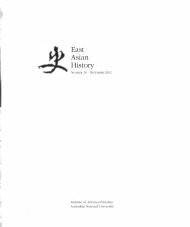Mujaku Dochu (1653-1744) and 17th-Century ... - East Asian History
Mujaku Dochu (1653-1744) and 17th-Century ... - East Asian History
Mujaku Dochu (1653-1744) and 17th-Century ... - East Asian History
You also want an ePaper? Increase the reach of your titles
YUMPU automatically turns print PDFs into web optimized ePapers that Google loves.
MUJAKU DOCHU<br />
shan Te-ch'ing LlJ1i&m 0546-1623), a rather orthodox Ch'an monk,<br />
mentioning only that Te-ch'ing had written an interpretation of Hui-neng's<br />
Platform Sutra in verseY7 He also quoted from Te-ch'ing's Words as<br />
Expedient Means (Fang-pi en yli 7J1]!:!D in his Numinous Rain of the<br />
Cloud Canopy (Wan'un reiu 1'nffi), stating he had made an error by<br />
saying that Huang-po Hsi-ylin ::ffi" (first half of the ninth century)<br />
had taught hua-t'ou, which in fact began much later with Ta-hui *<br />
0089-1 163)YS As far as I can see, he made no mention of Tzu-po Chenk'o<br />
i'BJr6J 0543-1603), <strong>and</strong> he did not use the works of Ou-i Chih-hsu<br />
ii:h§ 0599-1655) to any great extent.<br />
Chih-hsu was not a traditional Ch'an monk. He was, however, a major<br />
scholar of T'ien-t'ai <strong>and</strong> Ch'an, <strong>and</strong> his work was well known to Japanese<br />
Tendai scholars such as Reihl K6ken :m:Yt 0652-1739) of Anraku'in<br />
*,[ljG on Mount Hiei, who wrote, "If one reads Ou-i's Discussion of the<br />
Core Proposition (Tsung-Iun *§ffij) <strong>and</strong> does not burst into tears, he is<br />
sure to lack the mind of bodhi"Y9 Chih-hsu was also a major scholar of<br />
the bodhisattva precepts-including those in the Sutra of Brahma 's Net<br />
<strong>and</strong> the (pseudo-) surangama Sutra (Leng-yen ching fJll:t.) (from the<br />
perspective of Ch'an). He wrote more than 77 works, attempting to merge<br />
Tathagatagarbha <strong>and</strong> Yogacara thought. Thus in the scholar-monk Chang<br />
Sheng-yen's iJ:lH!-'* analysis, Chih-hsu was a Vinayist <strong>and</strong> Ch'an practitioner<br />
who used T'ien-t'ai as a methodology.12o Much could have been<br />
learnt from Chih-hsu, yet <strong>Mujaku</strong> did not make great use of his commentaries<br />
on the Leng-yen ching, the Lankavatara Sutra <strong>and</strong> the collection of<br />
essays known as the Conversations in the Monastic Rooms (Fan-shih ngout'an<br />
1M). In most instances, <strong>Mujaku</strong> only cited Chih-hsu to support<br />
a position or as evidence, <strong>and</strong> rarely criticised him. In fact he sided with<br />
Chih-hsu in relation to a refutation of Chu-hung's method of nien-fo in a<br />
phenomenal one mind of concentration <strong>and</strong> a one mind of principle 1 21<br />
<strong>Mujaku</strong>'s comment was that "reading this debate is sufficient as evidence<br />
of (the difference between) Chih-hsu <strong>and</strong> Chu-hung's depth of entry into<br />
the Way <strong>and</strong> the subtlety of their views., , 122<br />
In my limited reading of <strong>Mujaku</strong>'s extensive corpus, he made only one<br />
criticism of Chih-hsu for not distinguishing between "Thus Come Ch'an"<br />
(nyorai zen) <strong>and</strong> "Patriarchal Teacher Ch'an" (zushi zen) in his commentary<br />
on the Lankrivatara Sutra. For Chih-hsu the differentiation was<br />
simply a matter of being caught up in pointless language <strong>and</strong> wanting to<br />
use statements meant for specific circumstances in the past to create an<br />
underst<strong>and</strong>ing for all time. "How is it different from carving out a boat<br />
to get a sword? I am afraid Hsiang-yen would laugh at you., , 123 <strong>Mujaku</strong><br />
commented:<br />
"Thus Come Ch'an" is the words of the teachings. "Patriarchal Teacher<br />
Ch'an" relies on what the doctrinal preaching indicates <strong>and</strong> reflects back<br />
47<br />
1 1 7 Rokuso dank yo suichOso, A: 20b-21b.<br />
l1S Wa n 'un reiu, MSS, 548b<br />
119 Cited by Chang, Minmatsu Chugoku<br />
Bukkyo no kenky11, preface 2, from Reikll's<br />
preface to the Japanese print of Ou-i's<br />
collected works, the Lingjeng OU-i Ta -shih<br />
tsung-lun [Discussion of the Core Proposition<br />
by Master Ou-1 of Ling-fengl, which<br />
was printed in Kyoto in 1723.<br />
120 Chang Sheng-yen, Minmatsu, preface,<br />
pp.2-3.<br />
121 For details of this, see YD, The Renewal<br />
of Buddhism in China, pp.58-62.<br />
122 Wa n 'un reiu, MSS, 550a.<br />
123 Cited from Chih-hsD's Leng-yen ching i<br />
shu [Semantic Commentary on the Surangama<br />
Sutra], HIC 26.198bl-3.

















